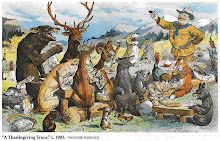British Columbia's Wild West-coast Wolves
The red-ochre or salmon-colored coastal wolves along the Great Bear Rainforest or mid-coastline of British Columbia are unique and dependant upon intact old growth forests that provide habitat for salmon bearing streams
.
.Over the past 300 years in North American humans of European descent have relentlessly hunted wolves. In fact, the British Columbia coastal wolf population has been drastically reduced by at least 80 percent.
Coastal wolves are the least known subspecies of gray wolves left on the planet. They live in rugged yet picturesque terrain, which receives more than 7 feet of precipitation annually.
Deadly efficient packs of 15 animals lead by an alpha male, move silently through the rainforests – over barnacles, moss and rock. Each pack occupies about 90 miles of space or home range including islands, forest covered mountains and caves – critical cover for protection during the winter months. A pack is able to move as much as 40 miles a day, most of the travel occurs during the night.
DNA hair analysis has recently revealed two distinct wolf populations: one on the outer-coast and the other on the inner-coast. The outer-coast packs eat: seabirds, shorebirds (cranes, geese and herons), small fish including cods, quillbacks, copper rockfish, salmon, mussels, clamshells, beavers, deer, beached sea-lions, seals, squid, and whales. The inner-coast packs have a similar diet except occasionally they will eat moose and mountain goats from the mainland.
Astoundingly, the outer-coast packs rely upon the ocean for 75 percent of their diet. Marine food accounts for only 50 percent of the inner-coast wolf diet.
In the fall, the small size and volume of the coastal island streams in the Great Bear Rainforest, enable both the inner- and outer-coast packs to catch salmon with a striking 30 percent kill rate. These wolves eat only salmon heads with brains that are high in omega-3 fatty acids – rich in nutritious calories.
Coastal wolves have not adapted to eating salmon stomachs loaded with parasites.
Salmon carcasses feed an additional 200 species in one of Nature's most elegant cycles that ultimately feeds invertebrates (spineless creatures) that sustain the next generation of salmon in that river – those salmon feed the wolves.









No comments:
Post a Comment